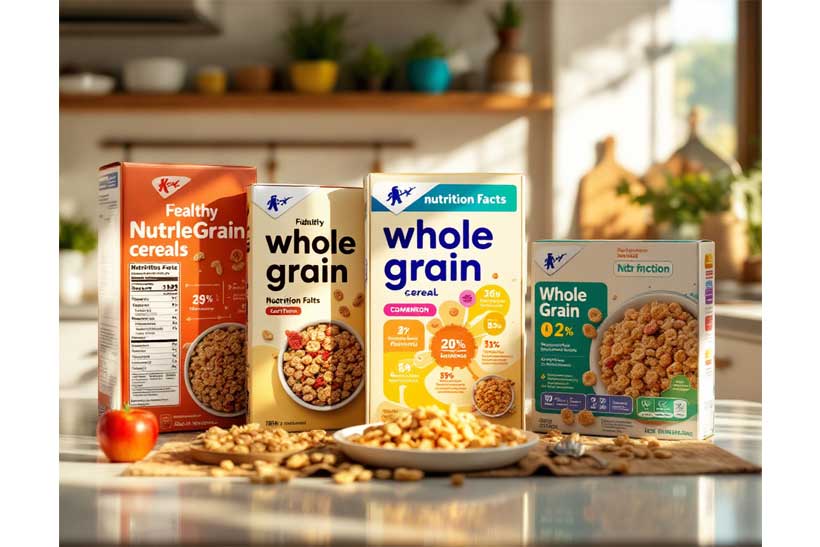Almost everybody enjoys a nice bowl of cereal in the morning, it is a great breakfast tradition! A nice big bowl of fresh, cool milk, maybe a bit of sliced strawberry or banana, raisins if you prefer, and of course that lovely golden cereal, crunchy at first, but soon transforming into a melt-in-your-mouth mixture with the milk that’s a delight to eat!
But what actually goes into the cereal we enjoy at breakfast? Cereal grains, which are the edible seeds of different grasses all belonging to the Poaceae family. There are plenty of healthy cereals in Australia to choose from, with hundreds of combinations of ingredients! Today we will take a detailed look at some of the most widely used cereal grains and why they are so great for your health!
Oats – Oats are Australia’s fourth largest grain crop, and that’s because they taste so good! It’s rare that oats have their germ and bran removed when being processed so when you eat products that list ‘oats’, ‘oat flour’ and ‘oatmeal’ in their ingredients, they will be wholegrain oats. Oats contain plenty of beta-glucan, which is a soluble fibre contained in the endosperm and bran and layers of the grain.
Whole Grain Oats Nutrition Facts:
- Contains vitamin E.
- Is high in carbohydrates, mainly in the form of starch.
- Contains multiple B-group vitamins like riboflavin, niacin, vitamin B6, folate, pantothenic acid, and thiamin.
- Is low in sodium and high in potassium.
- Contains manganese, copper, and calcium in small amounts.
- Has a 14% protein content which is higher some other cereals.
- Contains the following phytochemicals- phenolic acids, lignans, saponins, phytic acid, and plant sterols.
- Is high in beta-glucan, a soluble dietary fibre.
- The oat grain’s starchy endosperm contains more fat and protein than some other cereal grains.
- Contains zinc, magnesium, iron, selenium and phosphorus.
- Oats have the highest fat content of all grains at 8%. The fat is mostly unsaturated and is contained in the germ and endosperm.
Millet – Millet was once more widely consumed across Eurasia than rice was! Thought to be the hardiest of all grains, it tolerates very poor soil conditions other grains won’t grow in, so its use was very widespread until better farming practises emerged. Millet is a gluten free whole grain.
Whole Grain Millet Nutrition Facts:
- Is an excellent source of dietary fibre.
- Contains vitamin E.
- Is high in carbohydrates mainly in the form of starch.
- Contains small amounts of calcium, manganese, and copper.
- Is low in fat, most of which is unsaturated.
- Contains phytochemicals that include phytic acid, lignans, saponins, phenolic acids, and plant sterols.
- Is low in sodium and high in potassium.
- Contains magnesium, iron, selenium, zinc, and phosphorus.
- Is gluten free.
- Contains multiple B-group vitamins like riboflavin, thiamin, vitamin B6, folate, pantothenic acid, and niacin.
Rye – Rye outshines wheat as the most popular grain in Northern Europe. Rye tolerates harsh, cold climates, making it a staple of Scandinavian and Russian cuisines. Rye’s popularity worldwide has grown since it contains less gluten than wheat flour does.
Whole Grain Rye Nutrition Facts:
- Is low in fat, most of which is unsaturated.
- Contains a protein complex that forms small amounts of gluten.
- Is low in sodium and high in potassium.
- Contains vitamin E.
- Contains phytochemicals that include phenolic acids, phytic acid, plant sterols, saponins, and lignans.
- Is high in carbohydrate mainly in the form of starch), and has less gluten than other grains.
- Has a high protein content of about 15%, and a higher lysine content than most cereals.
- Contains multiple B-group vitamins like pantothenic acid, folate, riboflavin, thiamin, niacin, and vitamin B6.
- Is a great source of dietary fibre.
- Contains magnesium, iron, selenium, zinc, and phosphorus.
- Contains small amounts of calcium, copper, and manganese.
- Rye contains more soluble fibre than wheat does.
Barley – Barley originally came from Asia, where it was one of the first widely cultivated grains. Barley is a staple food for people living in less developed where it is difficult to grow wheat. Barley is high in beta-glucan and is often used in foods designed to promote cardiovascular health.
Whole Grain Barley Nutrition Facts:
- Contains vitamin E.
- Is low in sodium and high in potassium.
- Contains multiple B-group vitamins like vitamin B6, riboflavin, niacin, folate, pantothenic acid, and thiamin.
- Contains iron, magnesium, selenium, zinc, and phosphorus.
- Is low in fat, most of which is unsaturated.
- Has a very low glycemic index that helps control blood glucose.
- Contains phytochemicals that include phenolic acids, phytic acid, plant sterols, saponins, and lignans.
- Moderate protein content (10%) and contains a protein complex which forms gluten (although a smaller amount than wheat).
- Is high in soluble beta-glucan fibre which is found in the aleurone and endosperm cell walls.
- Contains small amounts of copper, manganese and calcium.
- Contains phosphorus, magnesium, iron, selenium, and zinc.
Wheat – Wheat is the world’s most widely cultivated cereal crop. Australia is the eighth largest producer and fourth largest exporter of wheat globally. Wheat is many people’s favourite grain and a breakfast cereal standard ingredient.
Whole Grain Wheat Nutrition Facts:
- Contains multiple B-group vitamins like riboflavin, vitamin B6, pantothenic acid, thiamin, niacin, and folate.
- Is low in fat, most of which is unsaturated.
- High in carbohydrate mainly in the form of starch.
- Contains vitamin E.
- High in potassium and low in sodium.
- Contains small amounts of manganese, copper, and calcium.
- High in insoluble dietary fibre.
- Contains B-group vitamins such as thiamin, riboflavin, folate, niacin, vitamin B6, and pantothenic acid.
- The endosperm contains glucofructan that functions as a prebiotic agent and a dietary fibre.
- Contains iron, magnesium, selenium, zinc, and phosphorus.
- Contains phytochemicals that include lignans, phenolic acids, plant sterols, saponins, and phytic acid.
- Is high in protein at 12-14% when compared to other grains.
- Contains a protein complex that forms gluten.
All of these grains share many traits, the difference is in the taste!














